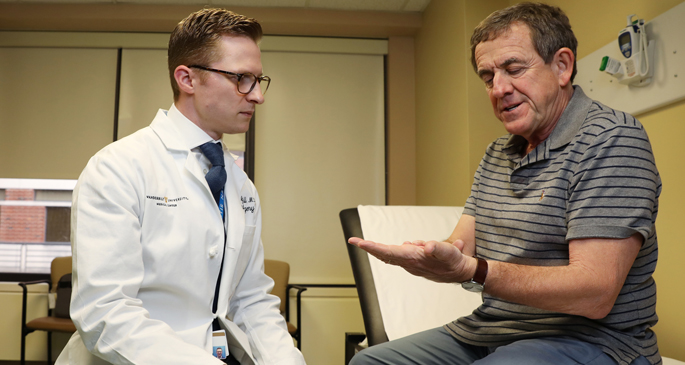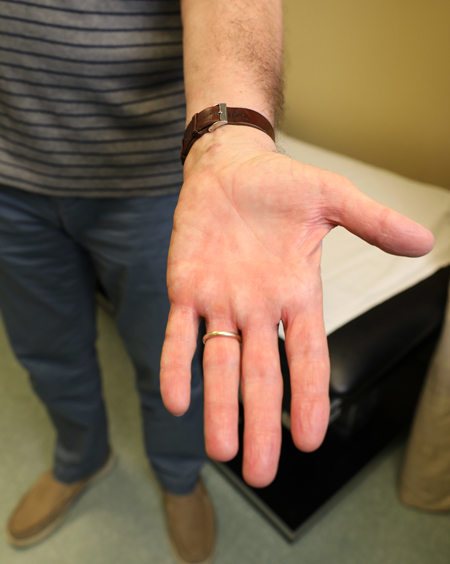
by Jill Clendening
Tommy Rainey suspects problems with his hands began as a result of countless hours at the keyboard during his long career as a publisher and writer, and when tingling and numbness in his left hand continued to worsen, he knew he had to get help.
The 66-year-old Nashville resident met with Vanderbilt University Medical Center hand surgeon Brad Hill, MD, and his main concern was that surgery might hinder his active lifestyle, especially his routine of using a rowing machine to maintain his health.
After a nerve conduction test, Rainey was diagnosed with carpal tunnel syndrome (CTS). This occurs when the median nerve, which runs from the forearm into the palm of the hand, becomes compressed. The carpal tunnel — a narrow passageway of ligament and bones at the base of the hand — houses the median nerve and tendons that bend the fingers. The median nerve also provides feeling to the palm side of the thumb and to three fingers and controls small muscles at the thumb’s base.
“I was really having a lot of tingling, and I knew something wasn’t right,” Rainey said. “I decided to have carpal tunnel release surgery for my hand, and I was able to quickly get back to doing the things I wanted to do. There’s just a tiny incision on my wrist a bit below where my watchband ends, and you barely notice it. It’s healed up great, and the tingling is improving.”
Hill championed use of the minimally invasive technique when he joined the VUMC faculty in the summer of 2019, and four VUMC hand surgeons in the Department of Plastic Surgery, including Hill, are now performing the endoscopic carpal tunnel release procedures.

While the minimally invasive procedure has been around for years with a well-documented history of effectiveness, it can be challenging to find a surgeon to perform the technique due to the need for additional training and specialized equipment.
Conventional open carpal tunnel release uses an incision about an inch long within the palm, which can significantly limit use of the hand and sometimes leads to delayed wound healing.
The endoscopic technique uses a much smaller incision in a wrist wrinkle, which often means less time spent in the operating room, a lower risk of wound-healing complications and a return back to work and regular activities sooner.
Both techniques are reliable, and studies comparing them show similar outcomes at six months after surgery. With any carpal tunnel release, there can be symptom improvement, but typically symptoms won’t continue to worsen.
According to the National Institutes of Health, carpal tunnel release is one of the most common surgeries in the United States. And while CTS was once commonly thought to be caused by an overuse injury or a repetitive motion such as typing, CTS can actually occur due to many factors that can combine to reduce space inside the carpal tunnel.
Contributing factors can include an injury to the wrist; an overactive pituitary gland; an underactive thyroid gland; diabetes; and rheumatoid arthritis. Work stress, repeated use of vibrating hand tools, fluid retention during pregnancy or menopause, or the development of a cyst or tumor in the canal may also contribute to nerve compression. CTS symptoms include numbness, weakness and pain in the hand and wrist, and it’s not wise to put off addressing the issue, Hill said.
“It can be dangerous to delay carpal tunnel release surgery because when that nerve gets pinched it’s not sending normal signals from your skin and to the muscles,” he said. “Over time, if the muscles aren’t getting normal signals and the muscles aren’t twitching, then the muscles atrophy. When the muscles atrophy, they don’t come back. It’s just like when you have a heart attack; the damaged heart muscle doesn’t grow back.”
During the endoscopic surgery, usually performed with light sedation rather than general anesthesia, a device that houses a tiny camera and a small knife is inserted through a small incision. The surgeon, who is able to visualize internal structures, carefully cuts the carpal ligament to decompress the median nerve.
“Often the best candidate for endoscopic carpal tunnel release is a patient with bilateral disease, or both hands affected,” Hill said. “If I were to do open carpal tunnel surgery on someone with bilateral CTS, and I did both hands, that would take both hands out of commission. It’s hard to bathe, brush your teeth and eat when you have a cut in both palms. If you just have a little one centimeter cut at your wrist, you can cover that with a Band-Aid, and then you’re often back to work in a week.”












